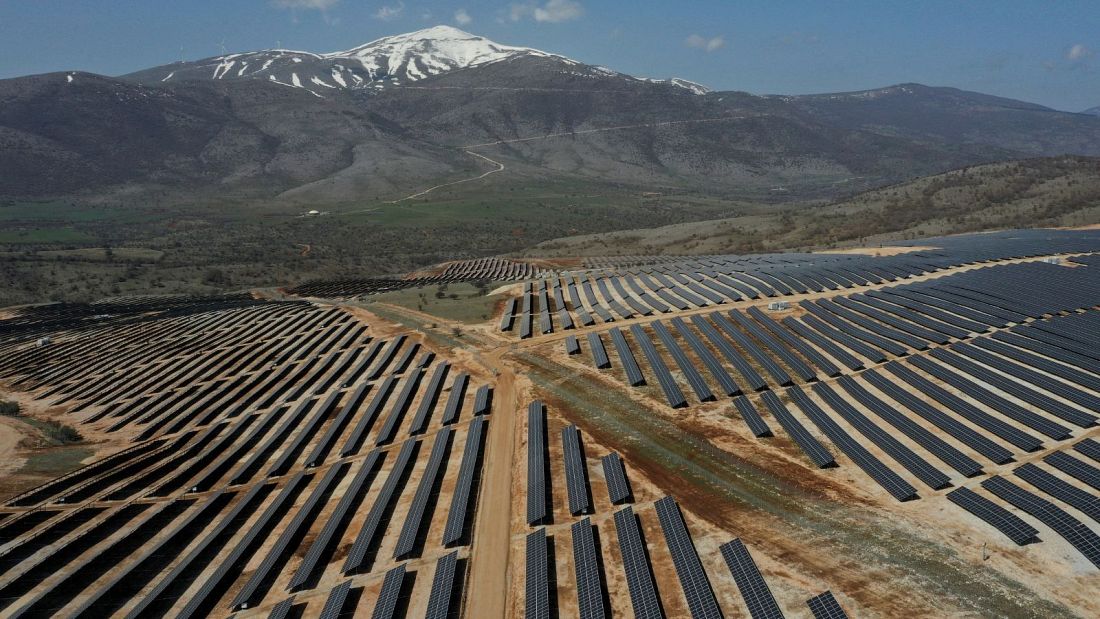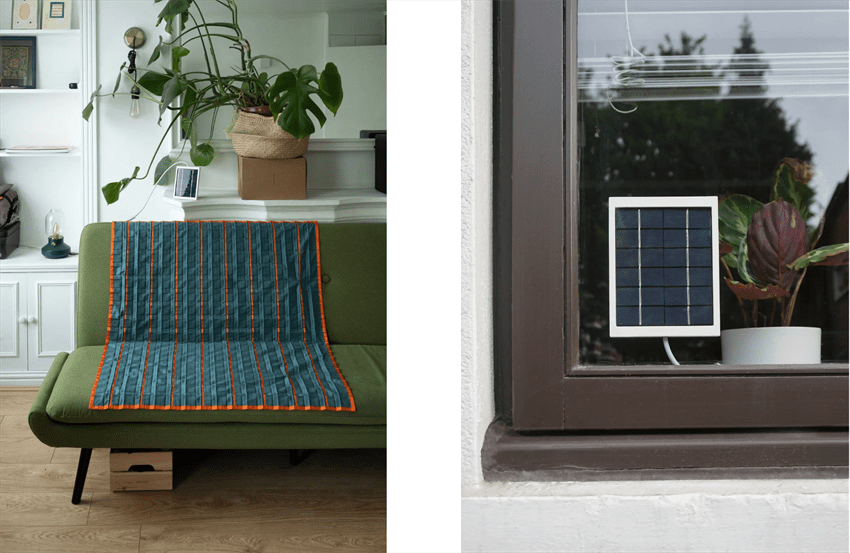
Our hearing organs start to develop at two or three weeks of gestation, and as we continue to develop in the womb we can hear well enough to react to sound. Sight may well be listed second in influential academic Marshall McLuhan’s ordering of the human senses into a hierarchy of importance yet traditionally, industrial design has focused on sight and touch, especially for expensive items. But, as we learn more about the design of infrastructure required for a net-zero emissions future, audio is becoming increasingly important in how we design, and for whom.
A more sustainable future means that our world will likely become quieter as energy-efficient technology has the potential to reduce noise impacts.
In most machines or systems, noise reflects a loss of energy in the system – energy being wasted rather than put to productive use. As we focus on reducing emissions and increasing energy efficiency, there is potential to achieve a quieter environment.
Creating power with solar panels or hydrogen instead of boilers and steam turbines; powering vehicles with batteries or hydrogen fuel cells rather than gasoline or diesel engines; electrifying rail lines to take diesel-electric locomotives out of service, and developing high-efficiency electric motors to make commercial processes (from air conditioning to manufacturing) whisper-quiet.
What are the ramifications of a quieter world as communities transition to net zero emissions, and how does that impact design? Could the noisiness of your factory floor or your suburb become a measure of how sustainable you are as a business or a community?
Do we need more or less noise?
This question is in the eyes (or ears) of the beholder. Rachel Carson’s seminal text ‘Silent Spring’, responsible for kicking off the modern environmental movement, argues that a healthy natural environment should be ‘noisy’ with natural life.
However, COVID-19 has revealed a mixed reaction to the relative silence that so many people experience from working remotely. For some, prolonged silence and isolation made them desperate for interaction with others; some introverts thrived in lockdown and never want to return to an office; others craved solitude after the noise of home-schooling kids, while trying to work.
Anecdotally, people are seeking out silence, as evidenced by the trend of city folks moving to regional centres. There is also the increasing use of noise-cancelling headphones, allowing people to curate their own audio environment, regardless of what sounds are actually around them.
The influence of increased or decreased noise on creativity, mental health and reflectiveness is probably down to the individual, although there are questions to be asked as we design this new audio world. Sound-masking systems conceal noise in new offices, but what if these became more common? Would organisations lose creativity if eavesdropping was lost? Research shows eavesdropping actually makes us better people. Could plugged-in employees result in decreased stress at the expense of less creativity and social engagement?
Hearing is a primal threat detector for humans and design has compensated for quieter noise in the past: for instance, the first cars were preceded by a person ringing a bell as a warning. Silence can be a problem, which is why electric trams and cable cars traditionally ring a bell to alert pedestrians to their approach, and why pushbikes have a bell on their handlebars.
Now, electric vehicle makers have synthetic sounds generated from their quiet motors – to make pedestrians aware that cars are around. While this has already become a legal requirement in the EU, other automakers are looking for workarounds: for example, Ford reportedly wants to include an ‘off switch’ for its line-up of police vehicles, presumably so officials can sneak up on suspected criminals.
How audio design can improve sustainable outcomes
Audio design in infrastructure could become a way to solve problems or achieve better sustainability outcomes. Look at start-up Ping Services, the creators of a stethoscope for monitoring the ‘health’ of wind turbines. Acoustic technology ‘listens’ to turbine blades to monitor their condition and helps predict degradation without early retirement, a common issue afflicting wind turbines.
The idea of creating an ‘acoustic fingerprint’ of well-maintained operating equipment, as a measure of equipment performance, has multiple applications across many industries such as mining and manufacturing. Ping, a small Adelaide start-up, is reaping the benefits of being an innovative first mover in using noise, or absence of it, as a measure of efficiency.
This movement towards less noise could change our property and settlement patterns, reducing urban sprawl. For instance, real estate next to busy roads may not necessarily lose value in a future of predominantly electric vehicles, because the reduced noise and reduced particulate emissions (no engines, less brake wear) will alleviate the impact on an amenity that a busy roadway would normally have.
A school in the Netherlands has placed acoustics at the heart of design under the premise that less noise equals less stress, illness and lower absentee rates. More than 30 000 m² of stone wool tiles and a long wall of reindeer moss supports the ceiling in creating a comfortable acoustical environment. Acoustic panels themselves are becoming more sustainable with options now made from chemical-free pulp.
The opportunities a net-zero future brings for design are endless. As roadways become narrower due to automated, quieter and non-emitting vehicles, the physical environment can be integrated further into design. Increased vegetation has the power to muffle harsh noise and absorb carbon dioxide. Just as rooftop gardens and flower walls are now commonplace, the best of Mother Nature’s audio like the calming benefits of birdsong could be incorporated on a broader scale.
Designing for silence
An electrified economy could potentially see increased audio pollution restrictions (for example, construction site noise limits, airport curfews) to reduce intrusions on people’s audio space. In the same way that smog and pollution were controlled in response to the industrial revolution’s excesses, the transition to a net-zero economy could include further control of public sound.
New regulations around use of drones already protect local wildlife, and sound laws have been enacted by governments and councils to account for technology that causes ambient public noise to recede from electrification and high-efficiency motors.
Not all of these will be reactions against sound: already, pleasant background sounds are actively introduced in places where people need to be calm, such as medical settings, or synthetic engine noise is simulated in electric vehicles to create a sportier sound upon acceleration.
Incorporating the design of sound into the built environment from the beginning is the best way to achieve a quieter environment, and avoids subjective tastes dictated by a few for the group. Already there are moves to design quiet spaces while, at the same time, we are warned of the psychological dangers of silence. Between the two extremes is a design challenge for perhaps audio-neutrality – more likely to be attained if we start with human need.
Decarbonising economies to combat climate change is a complex journey and won’t happen overnight, and neither will our response to lowering noise levels. Instead of the future soundscape being managed as an afterthought, more value could be obtained if we consider it early in the design phase, especially of workplaces and educational institutions, as a driver of qualitative measures such as engagement, fulfilment and purpose.
Sound is important to us. It is not only one of the first senses to develop, but it is also widely-believed to be the last sense people retain before they lose consciousness forever. While COVID-19 has provided an unexpected context in which to consider the audio environment we want to live, work and play in, climate change is providing ongoing opportunities to return to the sounds of nature.
You’ll have to keep listening to find out what a net-zero emissions future sounds like. Perhaps it might not only be smelling the roses, but also hearing the birds chirp. Wouldn’t that be a wonderful world!
Aurecon’s award-winning blog, Just Imagine provides a glimpse into the future for curious readers, exploring ideas that are probable, possible and for the imagination. This post originally appeared on Aurecon’s Just Imagine blog. Get access to the latest blog posts as soon as they are published by subscribing to the blog.
Source Eco News AU
















